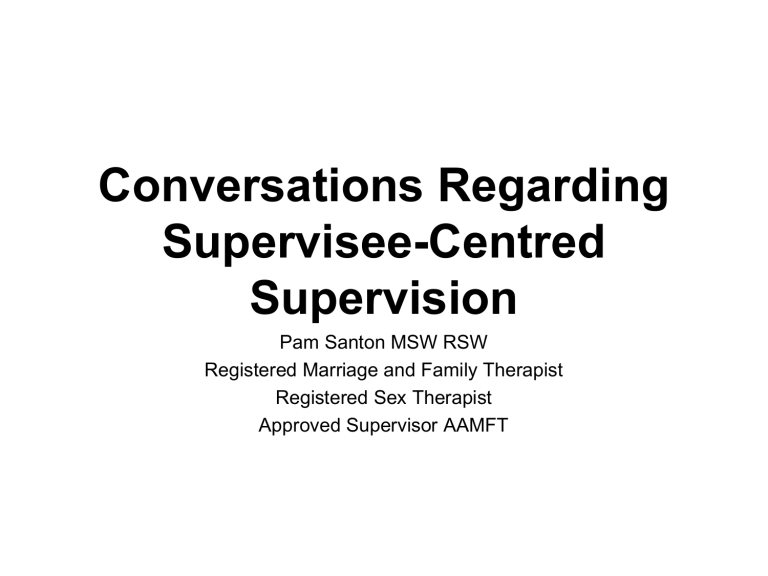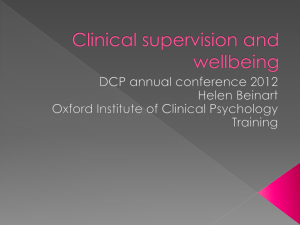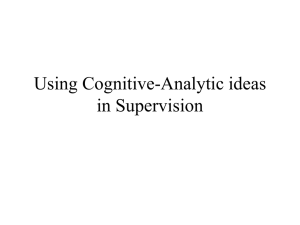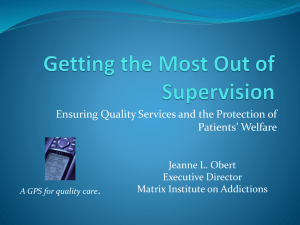MA1 - Supervisee-Centred Clinical Supervision

Conversations Regarding
Supervisee-Centred
Supervision
Pam Santon MSW RSW
Registered Marriage and Family Therapist
Registered Sex Therapist
Approved Supervisor AAMFT
My Objectives for Our Conversation
• To underline the importance of supporting supervisee’s in their support of clients through competency-based supervisory practices
• To review basics of Supervisory processes
• To emphasize the need for Reflective Practice in promoting the change process of clients
• To increase comfort with ‘Person of the Therapist’ methods of Supervision in promotion of the professional development of supervisees
• To allow reflection of supervisory practices
Positioning You in the Conversation
Reflective Exercise #1
• How many people in the room are currently supervisors?
Please take 5 minutes and talk to 3-4 of your neighbours about the following:
• How does your program currently provide supervision? Who gets supervision and when? Who supervises who? What is it like for supervisors? What is it like for supervisees?
• As you consider your current supervision system, what is working well? How do you know? And what do you think needs change?
How do you know?
Positioning Myself in the Conversation
• My own experience of receiving supervision, or not receiving it
• Clinical Director-ASYR 1992-2008: from 4 staff to 4 teams
• Supervisor in private practice since 1996 including the supervision of:
Individual therapists or a group of therapists working towards Clinical Membership or Approved Supervisor
Status with AAMFT
- Social Workers in the Ministry of Long-term Care and a Family Health Team
- Peer Support Counsellors in the Ministries of Labour and Natural Resources
- Students in a 4th Year Practicum Course in Family
Relations and Human Development
The Tricky Terrain of
Supervision in the Field of Addictions
Specific Challenges in the Work of Addiction
• Clients presentation: Poly-addictions including
Process Addictions, Co-occurring Mental Health issues, T rauma histories
• Visitor and Complainant Status of many clients and frequent no shows
• Family Dynamics of client system and their feelings of powerlessness
• Difficulties of clients with labelling and managing feelings which often results in slow pacing of the work and frequent relapse
• Polarized Models of Interventions
• Large caseloads and waiting lists
• Marginalization of the clients and their issues; and, therefore the field and those who work in it: underserviced, underpaid
Supervising in the Addiction Field
• High caseload numbers and long waiting lists to manage
• Staff presenting complicated client issues and the isomorphic pattern of powerlessness across the levels of the system
• Sometimes less than satisfied, stressed-out staff experiencing compassion fatigue, vicarious trauma and/or burnout
• Responsibility for vacation and sick leave coverage
• Own caseload to serve to manage
• Managers, Executive Directors and Boards to appease
Etcetera
Why ‘Supervisee-Centred’
Supervision
Frontline Staff as the Backbone of the agency!
The Risk of Empathy
“After all, it's our gift for empathy that draws us to our work. And yet, empathy at full throttle--felt and projected 100 percent with our bodies, hearts, and minds--has its risks.”
Babette Rothschild
UNDERSTANDING THE KEYS TO VICARIOUS TRAUMA
‘Boundaries Lost’
The Burnout Syndrome
• physical and emotional exhaustion as clinicians develop negative self-concept, negative job attitudes, and loss of concern for clients (Pines & Maslach,
1978).
• physical symptoms like fatigue, gastrointestinal irritations, insomnia, and hypertension (Farber, 1990)
• emotional symptoms including despair (Kestnbaum,
1984), boredom and cynicism (Friedman, 1985), withdrawal, and depression (Jayaratne & Chess,
1983).
• interpersonal problems , both in the workplace as well as with family and friends (Kahill, 1988).
Risk Factors
• Unrealistic therapeutic expectations
• Allowing personal issues to interfere in professional practice (loss of boundaries)
• Working with clients with particularly severe or traumatic issues
• Working in a community agency
• Being new to the field
• Being male
THE PROTECTIVE
FUNCTION
OF SUPERVISION
Supervisors as ‘Back Braces’
‘Strengthening the Core Muscles’
Myths of Individual Coping,
Realities of Organizational Policy
Kyle Killian 2007
“Stop blaming the victim for lack of life balance”
- Agencies to take responsibility for burnout by:
Better distribution of caseloads to ensure lower numbers of trauma clients per counsellor
Reduced caseloads and more reflective supervision
Better policies to give frontline staff an increased sense of control, efficacy & support
Clearly defined teams (Borrill 2000)
Participation in political advocacy
Role of Supervisor’s in the Prevention of Burnout
Rosenberg, T. Pace M., PhD 2010
• In-service training on burnout
• Setting expectations about self-care
• Limit-setting around client numbers and administrative duties
• Prioritizing supervision, peer meetings and
• support groups
• Modeling self-care, case consultation and self awareness
• Including person of the Therapist issues in supervision including: unresolved FOO issues, therapist’s need to be liked, over-involvement & feeling personally responsible for client-change
General Functions of Supervision
The Role of Supervision in Social Work
(An Irish Study 2010 Jeanne Marie Hughes MSW)
• Prevent stress and burnout in a profession dedicated to paying attention to someone else’s needs
(Hawkins and Shohet 2006)
• Contains or manages anxiety and helps to cope with the demands that the work entails (Brearer 1995)
• Supports reflective practice on the use of discretion and judgment (Gould and Baldwin 2004)
• Educates, supports and manages (Kadushin 1992,
Morrison 2003)
• Teaches, guides, counsels and directs
(Page/Wosket 1994)
• Facilitates learning, provides an opportunity to plan and evaluate work , supports workers and promotes good standards of practice and protection of the public (McGuiness 1993)
‘Great Supervisors’
• Non-judgmental and accepting of the supervisee’s inexperience and mistakes
• Accessible and Available regularly for conversations (weekly) (answer questions, offer advice and provide feedback)
• Collaborative as well as directive
• Trusting of their abilities and potential
• Trustworthy and respectful of their information and learning process
• Giving of their expertise and experience
• Modeling of professional practices, boundaries and conduct
• Culturally sensitive and Informed
Great Supervisor’s Build
Resiliency in Supervisees
• By building trusting, safe relationships
• By being present and modeling positive communication skills
• By being open and receptive to mistakes in themselves and others
• By modeling self care
• By being reflective and mindful in their interactions with supervisees
Components of
Quality Supervision
• Individual Supervision: 1.5 hours bi-weekly
(.5 administration, 1.0 clinical)
• Individual Training per learning Goals
• Group/Team Supervision
• Specific Training as a Team/Agency
• Peer Consultation- Formal and Informal
• Professional Consultation
• Supervision of Supervision
• Employee Assistance Program
According to the Literature
Addiction Counselling Competencies (98) The Knowledge, Skills, and
Attitudes of Professional Practice , TAP (Technical Assistance
Publication) 21 US Dept. of Health and Human Services, SA and MH
Services Administration, Centre for Substance Abuse Treatment 2008
Clinical Supervision Handbook A Guide for Clinical Supervisors for
Addiction and Mental Health , CAMH, 2008
Clinical Supervision and Professional Development of the Substance
Abuse Counsellor TIP ( Treatment Improvement Protocol) 52, US
Dept. of Health and Human Services, SA and MH Services
Administration, Centre for Substance Abuse Treatment 2009
Competencies for Substance Abuse Treatment Clinical Supervisor
TAP 21-A US Dept. of Health and Human Services, SA and MH Services
Administration, Centre for Substance Abuse Treatment 2008
The ‘Yin and Yang’ of Supervision
Supervision 101 :
Roles, Stages, Power,
Relationship, Parallel Process,
Reflective Practice
Structuring Supervision
The Yin/Yang Continuum
(
Jay Reeve- www.psychotherapynetworker.org)
Supervisory Practices
Technique- Based Process- Based
______________________________________________
- New to the field - Focus on clinical or position Experience
- Crisis management - Parallel Process
- Manualized treatment - Development of
Anxiety producing own therapeutic style situations (ethical, SI/HI, policies etc)
Above all else,
FLEXIBILITY and RESPONSIVENESS:
In Taoist philosophy, truth does not lie in one pole or the other, in yin or in yang .
Instead, the task of the sage is to provide what is lacking for balance and integration..
When they think they know the answers
People are difficult to guide
When they know that they don't know
People can find their own way
Tao Te Ching (S. Mitchell, trans.), Harper Perennial; 1991.
General
The Many Hats of the Supervisor
QuickTime™ and a
decompressor are needed to see this picture.
Idiosyncratic
Directive Collaborative
Isomorphism and Parallel Process in Supervision
• Origins in the psychoanalytic concepts of transference and counter transference
• Transference occurs when the counselor recreates the presenting problem and emotions of the therapeutic relationship within the supervisory relationship
• Counter-transference occurs when the supervisor responds to the counselor in the same manner that the counselor responds to the client.
• Thus, the supervisory interaction replays, or is parallel with, the counseling interaction.
Conversations about Parallel Process
• Can increase self awareness and professional growth
• Easier for the more experienced counsellor because of their confidence in their knowledge and methods of intervention
• Can cross the line into therapy so supervisee permission is always required
• Supervisor should always pay attention to how the therapeutic relationship and client issues are presented by the counselor in the supervisory session and use the awareness as an intervention in facilitating growth in the counselor, thereby helping the client
What Works in Therapy:
Project MATCH and the Alliance
Babor, T.F., & DelBoca, F.K. (eds.) (2003). United Kingdom:
Cambridge, 113.Treatment Matching in Alcoholism Treatment
• The largest study ever conducted on the treatment of problem drinking:
• Three different treatment approaches studied
(CBT, 12 Three different treatment approaches studied (CBT, 12- -step, step, and Motivational Interviewing)
• Difference in outcome between approaches..
The client rating of the therapeutic alliance was the best predictor of: T reatment participation; Drinking behavior during treatment; Drinking at 12- month follow up
The Clinical Responsibility of the Supervisor
Therefore … .
Anything the supervisor can do to reinforce the therapeutic alliance will improve outcome.
Sound clinical supervision, including reflective practice on ‘use of self’ and the person of therapist, needs to be a priority for every clinical setting.
Supervision Chain of Impact
Better
Outcomes
Quality of
Supervision
Positive
Impact on
Services
Quality of
Practice
The Supervisory Relationship
• The relationship is the key to successful supervision (Pritchard 1995).
• Trust is central to the supervisory relationship. Supervision cannot proceed in a climate of mistrust. Supervisor and supervisee must work to establish a trusting climate
• Supervisor must be diligent to avoid using information learned in the supervisory process against the supervisee (Munson
2002)
Power in Supervision: Recommendations for Supervisors and Supervisees
Murphy, M. 2005
• The results of this study highlight that positive uses of power can enhance the supervisory relationship.
• “it is imperative for supervisors to model appropriate uses of power for supervisees, so that they will appropriately use power with their clients.
- empowerment in the supervisory relationship isomorphically results with empowerment in the therapeutic relationship”
• Open Discussions of power include a) using the term Power in discussions b) talking about power at the first supervision session, and c) revisiting power as a discussion topic throughout the supervisory relationship.
Why Be Reflective?
• To Improve the quality of services
• To avoid clinical responses that can lead to unintended and negative consequences in sessions
• To replenishes counsellor reserves.
• To Avoid robotic practice, decisions, interventions.
• To builds confidence and creativity.
• To Strengthen: practice…service…advocacy…administration
• To foster empowerment, thoughtfulness, respect.
Objectives of Reflective Supervision
Modelling Empowering Relationships
• Supervisor and clinician form a trusting relationship
• Establish consistent, predictable meetings and times
• Ask questions that encourage details about the emerging relationship and the supervisee’s reactions
• Listen, emotionally present, teach/guide, nurture/support
• To Integrate emotion and reason
• To foster the reflective process to be internalized by the supervisee
• To explore the parallel process and to allow time for personal reflection
• To attend to how reactions to the content affect the process
Use of Self Model
‘Use of Self’ and ‘Person of the Therapists’ is a process through which therapists and counsellors learn how to use their personal emotional and cognitive reactions and knowledge of self in order to:
1) inform conceptualizations of their clients struggles
2) create a therapeutic relationship that is collaborative and conducive to corrective relating with the aim of overcoming difficulties and facilitating personal growth.
Examples of
‘Use of Self’ in Supervision
1) Feeling stuck around a separated couple and wanting them to reconcile.
2) Feeling powerless with a supervisee who wasn’t setting clear boundaries with a client
• Being triangulated in
FOO because of cutoffs in own family between siblings
• Inaction on the part of the E.D. to establish a policy around domestic violence
3) Anger at a client for frequent calls between sessions.
• Fear of client taking action on professional ethics
4)Dislike of a client for crying repeatedly in sessions.
• Feeling powerless with emotional pain
• Withdrawal as a protective move
How Personal Can
Supervision/Training Get?
Aponte 2004
1. Supervisees present their personal histories and information about their life circumstances
2. Although supervisors may inquire about what they believe is relevant, Supervisees are free to reveal only what they wish to reveal
3. Supervisees and fellow team/group members are bound by confidentiality for all personal information revealed in the context of supervision.
4. Supervisors and supervisees are not to assume a treatment contract (with all that implies) under the guise of supervision
5. Supervisees may pursue personal treatment outside the context of supervision, and Supervisors may assist in this pursuit as appropriate.
‘To Thy Own Self Be True’-
Building or Revisiting
Your Philosophy of Supervision
Beginning with
‘The Self’ of the Supervisor:
Modelling Authenticity
Have a Supervisory Road Map:
A Philosophy of Supervision
A template for conducting supervision sessions.
A roadmap of your principles, knowledge and behaviours as they relate to supervision.
Build a dynamic ‘Philosophy of Supervision’ that clarifies your values, insights and beliefs in this moment and review and update annually.
Components of a Philosophy of Supervision
• Influence
• Isomorphism
• Change and Components of Supervision
• Developmental Stages of Supervision
• Gender issues
• Accountability
• Ethical Issues
• Self of the Supervisor
Using a ‘Collage’ to define
Your Philosophy of Supervision
“I suggest that (Supervisees) avoid reifying human predicaments into symptoms…. All of this is mostly a matter of cleaning out enough psychological "debris" so that supervisees can sit comfortably, listen carefully, and think creatively. When I supervise, I give example after example of interventions that challenge clients' suppositions and help them explore new terrain. Then I hope for the best. Perhaps
Marsha Linehan, the inventor of Dialectical Behavior
Therapy, put it best when she advised new students to stop trying to act like therapists: "If they would act like themselves, they would be better off. . . . All you are trying to be is simply one human being trying to help another human being. That's all this is."
Unfortunately, the(diagnostic) category obscures that fact.” Jay Efran, Ph.D., Temple University.
Supervisee-Centred Supervision
Robert Taibbi: Clinical Director and Supervisor for 30 years www.psychotherapynetworker.org
“The administrative stuff plays second fiddle to your real job though: helping the supervisee--from scared beginners to confident (sometimes overconfident) pros to burned-out timeservers--figure out what they need and how to weave together their strengths, skills, and personalities into a unique and personal clinical style.
Obviously, you need good supervisory skills, but you must apply those skills in creative ways at different times with different staff because one size definitely doesn't fit all in this work.
It's the relationship between supervisor and supervisee (rather than a set of skills, per se) that's the key to helping him or her learn what it really means to be a therapist and practice therapy .”
Using a ‘Collage’ to define
Your Philosophy of Supervision
“I suggest that (Supervisees) avoid reifying human predicaments into symptoms…. All of this is mostly a matter of cleaning out enough psychological "debris" so that supervisees can sit comfortably, listen carefully, and think creatively. When I supervise, I give example after example of interventions that challenge clients' suppositions and help them explore new terrain. Then I hope for the best. Perhaps Marsha Linehan, the inventor of Dialectical Behavior Therapy, put it best when she advised new students to stop trying to act like therapists: "If they would act like themselves, they would be better off. . . . All you are trying to be is simply one human being trying to help another human being. That's all this is." Unfortunately, the(diagnostic) category obscures that fact.” Jay Efran, Ph.D., Temple
University.
My Personal
Supervision Philosophy
• Collaborative - power to as opposed to power-over
• Accountable to the client system and the agency
• Reflective in that the supervisee needs to be centred and grounded in their ‘use of self’
• Necessary - frontline staff as the backbone of the service
• Developing of the Unique Talents of the
‘professional part’ of the clinician
• Informed by client feedback and the literature
• Empowering of ‘the Person’ of the Clinician
• Strength-based - building on talents and abilities
• Mistake Friendly - aware that we learn through trial and error
Exercise #2
‘The Person’ of the Supervisor
In groups of 3 or 4, identify the following: a) The major models of therapy, counselling or change process that you value.
b) A life experience that you have had that informs your experience of supervision.
b) 2-3 Personal Strengths you bring to your
Supervisory Role c) 5- 8 adjectives that best describe your values in regard to your supervisory practices.
The Methods and Tools of the ‘Yang’ of Supervision
Methods and Tools of Reflective,
‘Use of Self’,
‘The Person of’ Supervision
CONTENT
• Learning Contract*
• Feedback Forms*
• Evaluation Tools*
• Genogram*
• Cultural Genogram*
• Professional
Genograms*
PROCESS
• Mindfulness
• Self Supervision
• Reflective
Conversations
• Supervision of
Supervision
• Outside Supervision,
Consultation and
Training
Mindfulness and Supervision
Mindfulness is intentionally being aware of what really is in the current moment
Jon Kabat-Zinn
The aim of supervision of clinical work ought to be supervision of the therapist’s own selfsupervision .
As Confucius said, Give a man a fish and you feed him for a day; teach him to fish and you feed him for a hundred years
(O’Hanlon & Wilk, 1987 ).
Benefits of Mindful Practice
Mindfulness and Supervision
AAMFT Supervision Bulletin 2010
• Reduces anxiety and increases calm demeanor
• Increases ability to be present and in the moment
• Reduces internal ‘chatter’ and negative self talk
• Increases self reflection and boundary setting
• Allows easier transitioning between clients or supervisees
• Increases clients/supervisee’s experience of being heard, validated and responded to
Goal: to increase therapeutic presence
Regular practice of mindfulness meditation with MFT supervisees resulted in significant improvement of in-session skills
- Increased patience
Increased ability to attend to the client’s experience
Increased ability to attend to one’s own experience
- Reduced reactivity and judgment
- Better handling of challenges
Methods of Mindfulness Meditation:
Practices that bring the clinician’s awareness fully into the present without judging or evaluating that experience
• Meditation
• Body Awareness: Body Scan- what is your body telling you
• Body Movement: dance, walk
• Journaling
• Art
The Reflective Supervisory Conversation
(Leonardo daVinci Institute, The Netherlands 2008)
Discuss the alternatives
Co-construct new ideas
Explain your point of view
Discover supervisee‘s point of view
Clarify Reception
Active Listening
Observation
Prompting Phrases for
Reflecting Practice
• “I’m wondering…”
• “Can we explore for a moment…”
• “What are your thoughts on…”
• “How would you approach…”
• “What are the possibilities you see in…”
• “How will your strengths…”
• “Can you tell me (a little more) about…”
• “How would you describe…”
• “What would happen if you tried…”
• “How do you understand/Can you help me understand…”
• “If you viewed this from
________’s perspective, what would you see…”
• “What do you need from me today to feel supported…”
BASIC USE OF THE
GENOGRAM
• Chronicle families and major elements of their histories over a minimum of three generations(McGoldrick&Gerson,1985)
• Provide graphic annals of families membership, characteristics, and interpersonal relationships
• Reflect the transmission of family patterns from generation to generation (Kuehl, 1995) and provide a provisional blueprint for change
(Lieberman, 1979, p. 57).
Reflective Exercise #3
The Cultural Genogram
Constantine 2003
• In your small groups, discuss the demographic variables you use to identify yourself culturally including SES, race, ethnicity, religion, gender/sexual identity, education etc.
• What worldviews (e.g., values, assumptions, and biases) do you bring to supervision based on your cultural identities?
• What struggles and challenges have you faced working with supervisees who were from different cultures than your own?
Cultural Awareness Continuum in Supervision
Cross,1989
• Cultural Destructivenesssuperiority of dominant culture and inferiority of other cultures; active discrimination
• Cultural IncapacitySeparate but equal treatmentpassive discrimination
• Cultural BlindnessSees all cultures and people as alike and equal; discrimination by ignoring culture
• Cultural Openness (Sensitivity)Basic understanding & appreciation of importance sociocultural factors in work with minority populations
• Cultural CompetenceCapacity to work with more complex issues and cultural nuances
• Cultural ProficiencyHighest capacity for work with minority populations; a commitment to excellence and proactive effort
Culturally Responsive Supervision
• Inclusive of the multiple awareness of self and other
• Multi-cultural competence as a stated mutual goal of supervision
• Strong working alliance in supervisory dyad supports trust and respect vital for risk-taking, development of self-awareness and multicultural sensitivity
• Self awareness is a prerequisite for multi cultural competency (Richardson&Molinaro
1996)
Teaching Multicultural Competence
Encourage
- acceptance and respect for cultural differences in supervisor/ therapist/client relationships
- adaptation of supervisory/therapeutic approaches to fit socio-cultural contexts
- self-awareness regarding the impact of values, attitudes, biases and cultural differences
- acquisition of cultural knowledge and sensitivity
- a multicultural experience in the world
- provision of services to accommodate diversity in culture and socioeconomic status
- reflection on beliefs and behaviors related to age, gender, ethnicity, power, religion/spirit uality, context, etc.
Seek factual knowledge when faced with new cultural situations
• Develop an open and sensitive working alliance with your supervisee
• Practice Mindful awareness and teach it
• Be aware that matching of supervisor and supervisee personal characteristics does not seem to be crucial in the creation of meaningful relationships
• Recognize that the ability of the supervisor to discuss similarities and differences seems to be the critical dimension
The Professional Genogram
Magnuson (2000)
• to examine influences of professional mentors, authors, and theorists.
• parallel the family genogram structure
• feature a chronology of direct professional mentors, influential theorists and philosophies above participant symbols
• lines can be added to illustrate relationships between the persons, philosophies, and entities that are symbolized
• provides a forum for examining assumptions that inform the person-of the-professional
Reflective Exercise #4
With 3-4 other participants discuss what methods of Reflective Clinical
Supervisory practice you are currently using and find helpful.
What other method or tool will you try next week?








